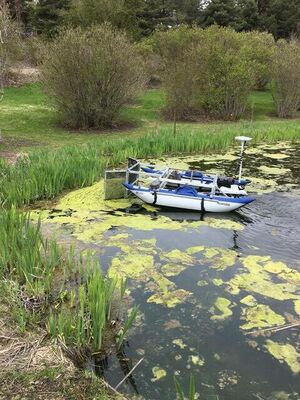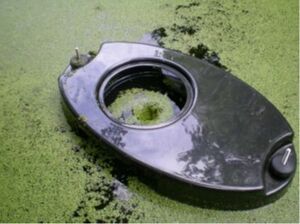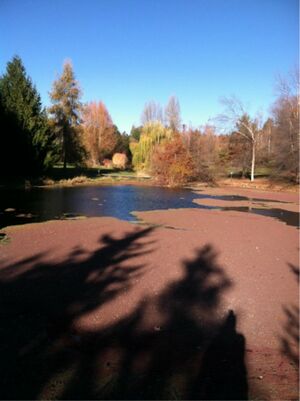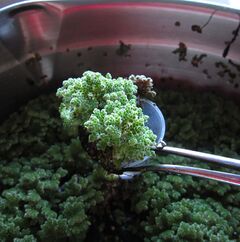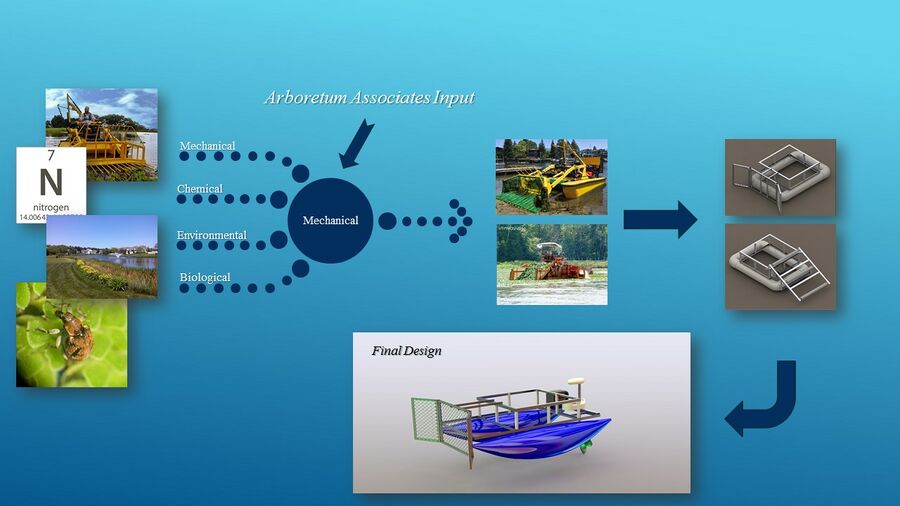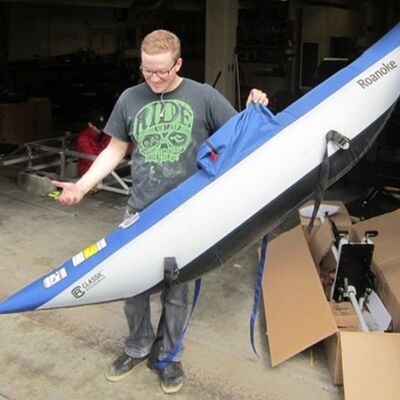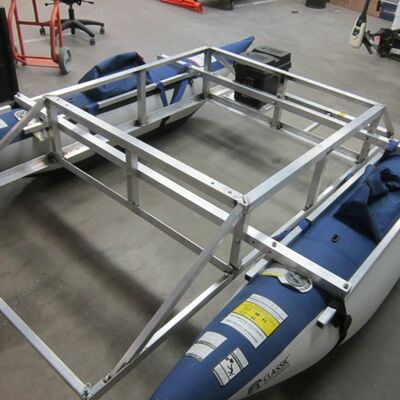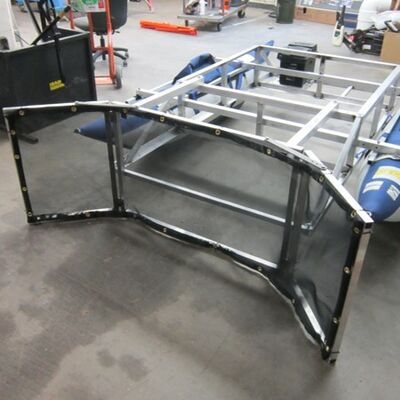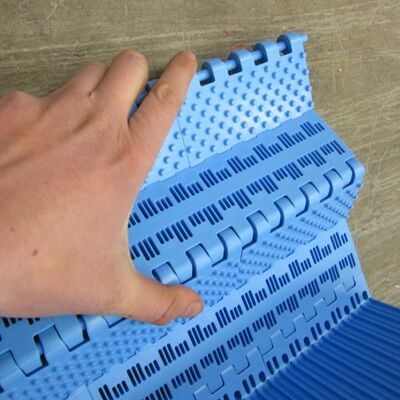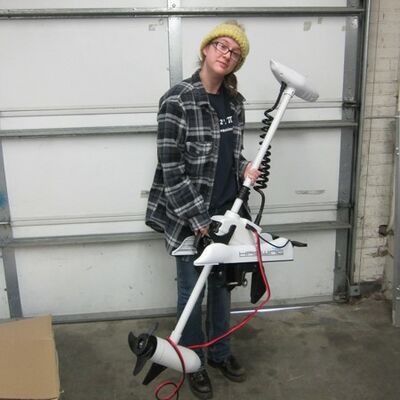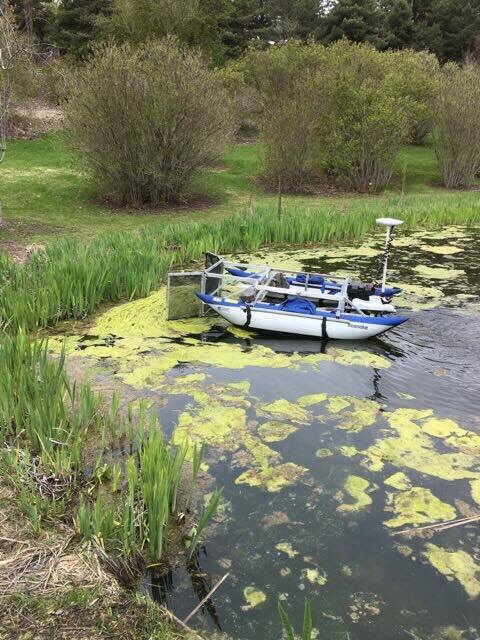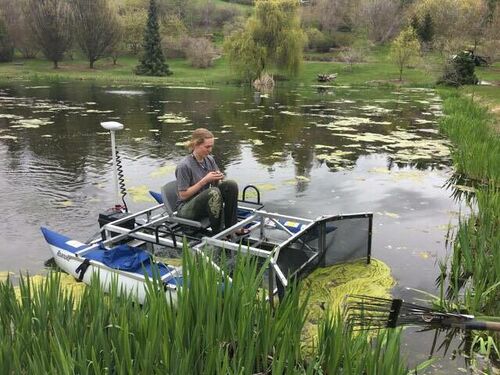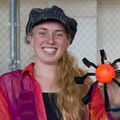Aquatic Weed Removal
| Plowing the pond | |
| Team Name | Nemo |
| Clients & Support | |
| Team Members | |
| Duration | Fall 2016 - Spring 2017 |
| Faculty Advisers | Dr. Dev Shrestha |
| Shop Mentor | James Founds |
| Client | Paul Warnick and Arboretum Associates |
Team Nemo is building a remote controlled aquatic weed harvesting boat. For the past few years the ponds in the University of Idaho Arboretum have been carpeted with duckweed and Azolla. The weed harvesting boat has been commissioned to address the overgrowth. It will provide caretakers the ability to cut back growth immediately, and by removing biomass it will reduce the nutrient overload which is causing the problem. Similar commercially available machines are much larger and are driven by an on-board operator. Our boat will better suit the scale and needs of the arboretum.
Problem Definition
Problem Statement
The excessive aquatic weed growth in the arboretum ponds is not aesthetically pleasing. We are looking for a long term, ecologically friendly, low-maintenance, and cost effective solution.
Background
Two small ponds were dug in the UI arboretum several decades ago. They were lined with bentonite and filled with natural runoff from rain and the arboretum irrigation system. The irrigation system runs on reclaimed water, which is presumably nutrient rich. The ponds have low circulation volume (a pump at the bottom of the arboretum recirculates water back to the head of the upper pond through a 2" pipe.) These conditions encourage nutrient buildup and weed growth.
Previously Attempted Solutions
The Arboretum Horticulturist (Paul Warnick) has made several attempts to solve the weed problem, but none have achieved desired results.
| Attempt | Type | Explanation/Cause of Failure | |
|---|---|---|---|
| 1 | Aquatic Herbicide | Herbicide | Weed decomposition suffocated fish |
| 2 | Proskim Skimmer | Mechanical Removal | Clogs on feathers/snail shells |
| 3 | Aluminum Sulfate | Nutrient Re-balance (tie up Phosphate) | Unusable due to high pond pH |
| 4 | Grass Carp | Biological Control | Carp do not seem to be keeping up with weed growth |
| 5 | Aeration | Nutrient Re-balance (tie up Phosphate) | Seemed to help, but not sufficient |
The following specifications are important to our client in order for an attempt to be considered successful.
Design Specifications
| Specification | Specific Requirements | Target Values | |
|---|---|---|---|
| 1 | Labor | Low operator hours | 8 man-hours per week or less |
| 2 | Maneuverability | Low weight, movable by 1-2 people | No component more than 100 lb |
| 3 | Maneuverability | Reasonable size | Under 10 ft long |
| 4 | Cost | Within budget | Under $15,000 |
| 5 | Safety | Safe for operator, other pond life | Negligible risk with proper operation |
Project Learning
Weed Types
Duckweed, water meal, Azolla, and filamentous algae are all common water weeds which prefer quiet nutrient rich water. All but filamentous algae are free floating plants, and in other situations can be valuable as fertilizer or animal feed.
Azolla is able to fix nitrogen into a usable form directly from the atmosphere through symbiotic relationship with cyanobacteria. This means it contributes even more to the nutrient buildup in the pond as it decomposes. Because it always has a ready supply of nitrogen, phosphorus tends to be the limiting nutrient. Azolla has a competitive advantage when Nitrate:Phosphate ratios are low.
Pond Chemistry
Ponds with low circulation tend towards eutrophication, or nutrient overload. This is especially true when they are subjected to run-off from fertilized lawns or fields, a definite condition in the Arboretum. Eutrophication encourages weed overgrowth, so removal or locking of nutrients in the system is a necessary part of pond maintenance. This can be done through removal of biomass (for instance weeding or harvesting fish), through draining and refilling, or through any biological or chemical process which causes nutrients to either escape or bond into an unusable form. Phosphorus is especially hard to remove because it has no gas phase.
Because Azolla has a competitive advantage when the nitrate:phosphate ratio is low, increasing the nitrogen levels may help discourage that particular infestation. If the ratio of dissolved inorganic nitrate to dissolved inorganic phosphate (DIN:DIP) is less than 10:1, Azolla likely has a competitive advantage. (Source: Dr. Wilhelm, UI College of Natural Resources) To find the DIN:DIP ratio, it is necessary to measure the concentration of nitrate and ammonia (components of DIN) and phosphate (DIP).
Azolla Density
The density of wet weeds is needed in order to design volume-to-weight capacity ratios for the boat and to estimate area cleared per trip. Most of the weed mass is Azolla, so we are using its density as a working estimate. We could not find any sources which listed Azolla density, so we measured a wet sample ourselves and found the density at approximately 17-20 pounds per cubic foot. An interesting note: Azolla is highly water repellent (like duck feathers) so even during collection it is unlikely to gain much waterlogged weight.
Material and Hardware
In designing the boat and choosing from available parts, we have researched and considered a lot of information on materials and standards. Often the best place to start is reading about existing machines which fulfill similar functions or operate in similar conditions as the boat we are designing. Looking up paddle-boats, for example, provided good information about how different types of metals (aluminum vs. stainless vs. galvanized steel) hold up in different types of water. Similar sources also brought up how to avoid galvanic corrosion when matching fasteners, a problem which would not have likely even occurred to us as amateurs. Moving into the more concrete parts of design - choosing from available hardware - also implies a lot of learning. For instance, considering options for the conveyor brought up everything from sizing with ANSI sprocket specifications to types of positive drive conveyor belting. The overarching lesson here is that a cost-effective design uses parts and sizes in common use.
Design
Design Process
The problem was at first very open ended: we were simply requested to reduce the weed problem by any means possible. We began by brainstorming a variety of ideas, which we presented to our client.
| Type | Possibility | |
|---|---|---|
| 1 | Mechanical | Remote Controlled Water Plow |
| 2 | Remote Controlled Conveyor Collection | |
| 3 | Manned Version of Plow or Collection | |
| 4 | Chemical | Nitrate Addition (Remove Azolla Advantage) |
| 5 | Enviromental | Buffer Zone |
| 6 | Partial Pre-rain Drain (Water Renewal) | |
| 7 | Added Aeration | |
| 8 | Biological | Azolla Weevil |
Final Design
The Arboretum Associates were most interested in a mechanical solution. The remote control aspect appealed to them, and they liked both the plow and conveyor ideas. We decided to construct a boat which could support either a plow or conveyor attachment, so both could be tested. Our theory is the collection method will be more useful for low-density growth, while the plow will be more effective for a thickly overgrown pond. During construction our initial detailed design had to be modified. For instance, we had planned to use PVC pipes to provide buoyancy, but found that the inflatable pontoons from a fishing boat were a much lighter and better solution.
| Photo | Overview | Photo | Overview |
|---|---|---|---|
Pontoons
|
Frame
| ||
Plow
|
Conveyor
| ||
Motor and Battery
|
Onshore Conveyor
|
Implementation and Testing
Our full-system test with the plow went well. We drove it around unmanned for a while, but found that it also worked very well as a manned craft. (We were still using the remote control, just at a much shorter distance.) This adds a nice option, especially until we have a more reliable remote control connection. A couple improvements to be made became evident during the test:
- When the plow is being used without a rider on the boat, it will need added weight in front to keep the boat level.
- A wider plow would be no trouble for the motor to push, and would make work more efficient.
|
The test was made on May 1, so the weed growth was still low. However, the plow performed well on the weeds which were present.
|
Future Work
Our motor currently has a remote control range of 30-50 ft. A longer range remote system needs to be constructed which integrates a kill switch and the controls for the on-board conveyor belt with the controls for the motor. We decided not to pursue this in the time constraints we had because we thought it should be done thoroughly and robustly. Attempting to adapt the motor without enough time to do it properly risked breaking it.
The points we discovered during testing would be simple to solve and good to consider - adding a removable weight to the plow is a trivial problem, and making a wider plow would be simple.
If a future team takes up the project, we think it would also be wise to monitor the nutrient levels in the pond, and begin to build up a better understanding of the affecting factors.
Team Members
| Team "NEMO" | |||||
|---|---|---|---|---|---|
| Member | Biography | Discipline | |||
| Bryan Barrett | I’m from Coeur d’Alene, ID. I love nature and am interested in the eco-hydrological side of Environmental Engineering. | Biological Engineering | |||
| Nicole Fletcher | I was born and raised in Seattle, Washington. I am currently working on my final year of school and hope to be working with biohazardous waste and damaged ecosystems doing bioremediation and restorations when I graduate. | Biological Engineering | |||
| Autumn Pratt | I'm from Moscow and am in my final year here at UI. I plan to go to graduate school next year, hopefully doing research in robotics. Biologically inspired engineering and soft robotics are particularly interesting to me. In free time I like writing, music, and almost anything outside. | Mechanical Engineering | |||
| Stephen Walters | I am from Meridian, Idaho and enjoy the outdoors, dirt-biking, and working with heavy machinery. | Mechanical Engineering | |||
| Sarah Willis | I’m from Kooskia, Idaho. I particularly enjoy 3D solid-modeling and Mechanics of Materials. Interests outside of school include spending time with friends and family and listening to music. | Mechanical Engineering | |||
